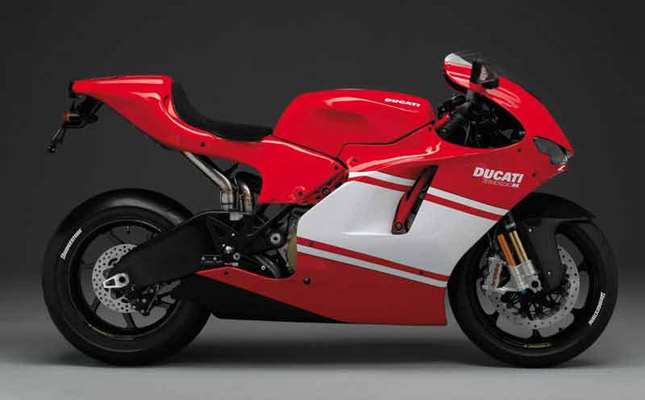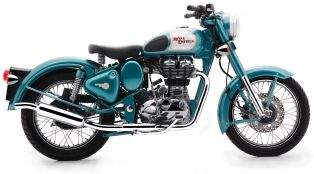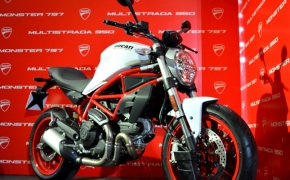 What is a V4? It’s a type of engine consisting of 4 cylinders in a V shape. You may have heard about the Parallel Twin on Yamaha’s R3. They work their magic in a phenomenal way but coming to the MotoGP, You need something more than good old’ magic. You need something evil. You need witchcraft and that is what actually this Engine is, the all new Ducati Desmosedici Stradale V4. Just the name of this thing makes it sound like the big monster created by an insane scientist.
What is a V4? It’s a type of engine consisting of 4 cylinders in a V shape. You may have heard about the Parallel Twin on Yamaha’s R3. They work their magic in a phenomenal way but coming to the MotoGP, You need something more than good old’ magic. You need something evil. You need witchcraft and that is what actually this Engine is, the all new Ducati Desmosedici Stradale V4. Just the name of this thing makes it sound like the big monster created by an insane scientist. Engine Specs and their Translation:
• 1,103 cc 4-cylinder 90-degree V4, rearward by 42 degrees.
Translation- Larger Engine capacity. The 90 degree V4 configuration makes the engine compact and provides better mass centralization. This optimization of weight results in the installation of large radiators and forward focused swingarm pivots.
• Compression ratio 14:1
Translation– Higher the Compression Ratio greater is the power produced by the engine. Higher compression ratios place the fuel and the air into a small area, combining it with adiabatic heat generated from compression, resulting in greater evaporation and mixing of the fuel droplets in the combustion chamber.
 • Power > 210 HP @ 13,000 RPM and Torque>120 NM @ 8,750 to 12,250 RPM.
• Power > 210 HP @ 13,000 RPM and Torque>120 NM @ 8,750 to 12,250 RPM.Translation– “Our Yamaha will never go as quick on a straight as the Ducati!” quoted Valentino Rossi in the 2007 MotoGP season about “GP7” an earlier generation Desmosedici engine. So you can only imagine how fast the new engine will be.
• Counter-rotating Crank shaft
This opposite rotating motorcycle component decreases the gyroscopic effect as the heavy crankshaft doesn’t act upwards, which in turn prevent the power wheelies and also helps in improved handling and an aid in quick direction.
• Twin Pulse firing sequence, crank pins offset at 70 degree
Translation– This means that the twin cylinder stroke at the same time, same as that on Desmosedici GP, this sequence gives Desmodici Stradale a unique signature sound. Twin pulse also generates easy to handle power delivery and optimizes out of the corner traction.
• Variable height air Intake horns and injectors
Translation– Proper air intake across the rev range results in improved power delivery and handling. Oval throttle bodies consist of two injectors; one above the butterfly and one below it, this completes the fueling system.
 Other specs include:
Other specs include:• Bore X stroke 81 x 53.5 mm
• EURO 4 emission norms
• DOHC with 4 Valves per cylinder
• Wet multi-plate clutch
• Semi-dry sump lubrication with four oil pumps
• 6-Speed gear box with DQS up/down system
• 24,000 km “Desmo-service” maintenance interval
The engine weighs in at just 64.9 kg; Desmosedici Stradale is just 2.2 kg heavier than super Quadro twin which has a cubic capacity of 1285 cc. The origin of this engine has its roots in the soul Ducatis of V4 MotoGP engine. The dimension and the geometry of its cylinder heads are identical in both the GP version and this engine. • EURO 4 emission norms
• DOHC with 4 Valves per cylinder
• Wet multi-plate clutch
• Semi-dry sump lubrication with four oil pumps
• 6-Speed gear box with DQS up/down system
• 24,000 km “Desmo-service” maintenance interval
The forward pivoted swingarm also means that the engine has been designed as a structural chassis element. The upper crankcase and rear cylinder bank head of the main frame incorporate attachment points. The function of the crank case also includes acting as a rear suspension and swingarm attachment points.
History behind the Revs:
 The story goes that many years ago Ducati abandoned the Grand Prix completely as the 500cc class consisted only 2-Stroke motorcycles whose spot was removed from the company’s stable long ago. In 2002, Rules changed, 4-stroke machinery was introduced this was the chance when for the company which was eagerly waiting for a comeback in the game.
The story goes that many years ago Ducati abandoned the Grand Prix completely as the 500cc class consisted only 2-Stroke motorcycles whose spot was removed from the company’s stable long ago. In 2002, Rules changed, 4-stroke machinery was introduced this was the chance when for the company which was eagerly waiting for a comeback in the game.RELATED ARTICLE: Ducati's Renaissance In The World Of MotoGP
Initially the company thought of creating a ‘Super Twin’, as it was an advantage over 3,4, or 6 cylinder bikes because of weight reduction but in order to produce more than 230 HP the engine had to be revved really high @ 17,000 RPM (Approx) giving the rise to the requirement of a very short stroke and a very large bore. This would be a problem in combustion.
Enter the Desmosedici engine, where the Desmosedici, an Italian word translates into Desmodromic distribution with sixteen valves. As there are four Cylinders with 4 Valves per cylinder and 2 of those cylinders together on one side making a V design with the other two cylinders. The Desmosedici Stradale is derived from the Ducati Desmosedici GP. This is the brief history of how that revolutionary engine came to be which in turn gave a birth to Stradale V4.
The bike was revealed at Mugello during Italian GP, and then subsequent seasons starting from 2003 to all the way to 2016 saw regular improvement on the bike but the surprise came in 2004 when Ducati announced that a low volume race replica (RR) version will be made whose reservations will begin in June 2006. This was the first time when a true MotoGP bike will be made with all the necessary safety features to be driven on public roads. The bike came to be known as Desmosedici RR which had a top speed of 188 mph.
RELATED ARTICLE: Winglets In MotoGP- A trend set by Ducati, followed by others
In the 2007 MotoGP rules were changed to cap the maximum displacement in motors to 800cc. Ducati made the GP7 bike in response which had 4 cylinders, 225 HP, and a top speed north of 330 km/h. GP8 saw an improvement in the improved mid and top range.
The next big change came about in 2010 which introduced the “BIG-BANG firing order” which refers to the design of the engine resulting in the power strokes occurring simultaneously or in very close succession.
MotoGP rules were again changed in 2012 to which Ducati responded by making engine capacity to 1000 cc later In 2016, the GP16 bike was introduced by Ducati which till that date was again the fastest one in a straight line. The liquid-cooled, 90-degree V4, 4 strokes with 16-valves Desmodromic DOHC did its job exceptionally well as a result in the 10th round of the season in Austria, Ducati dominated all of the sessions.
 Final Thoughts:
Final Thoughts:So to summarise what the big deal about Stradale V4 engine is that it helped Ducati to stay at the top of the game through many seasons in MotoGP, it proved to faster every other bike on the track and it is feared even by The Valentino Rossi himself. To achieve even a single of the above-mentioned tasks is an astoundingly difficult feat. But Ducati has done it in the form of Ducati Panigale V4 and now the ultra-rich among you will get a chance to feel that rich MotoGP heritage comprising of enough power and torque to pass any hypercar you see on the road when it is finally unveiled at EICMA show in Milan in November.
So for the things related to bikes and upcoming EICMA, stay tuned to BikesMedia.
By: Yetnesh Dubey






















